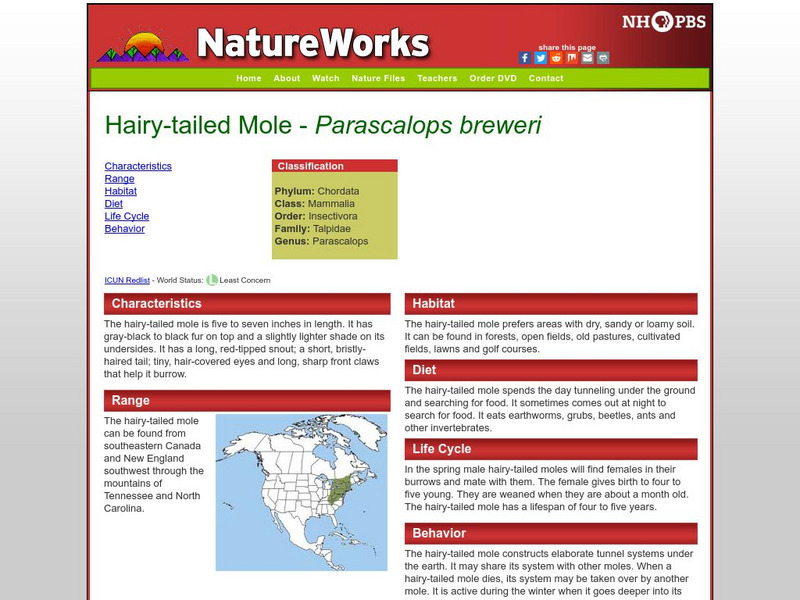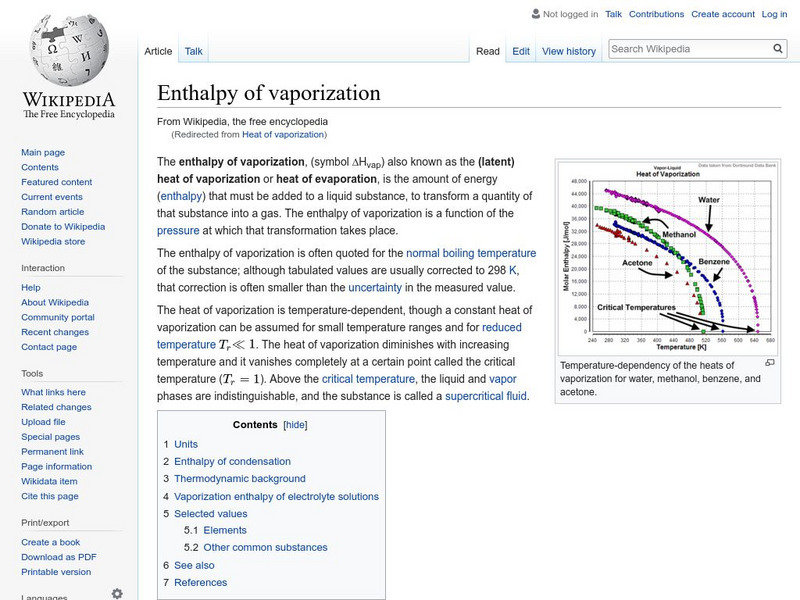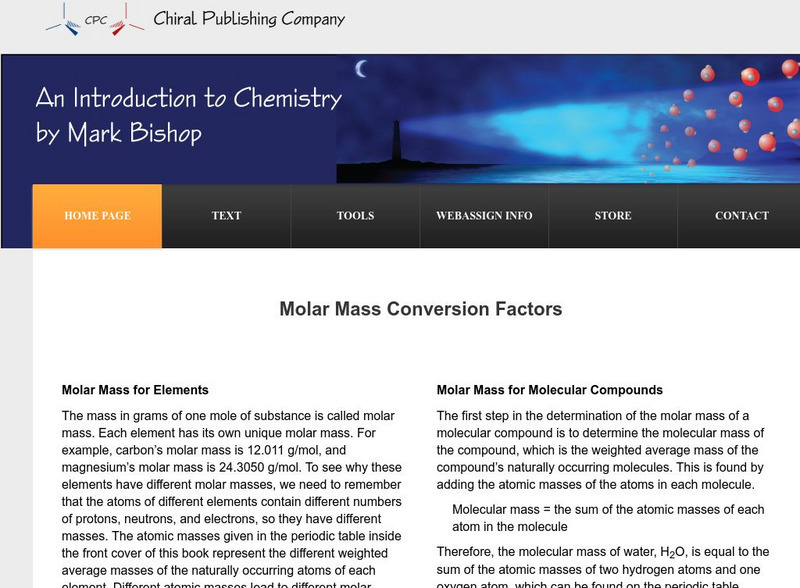PBS
Nh Pbs: Nature Works: Hairy Tailed Mole
Discover what makes the Hairy-Tailed Mole unique? This site features photographs of this insectivore and information ranging from characteristics and habitat to life cycle and behavior.
Texas Instruments
Texas Instruments: Mole
This activity is designed to assess the comprehension of concepts related to moles.
Simon Fraser University
Chem1 Virtual Textbook: Mixtures of Gases
The General Chemistry Virtual Textbook, or Chem 1, is broken into several sections covering various aspects of topics related to chemistry. This section deals with gases and specifically mole fractions and volumes.
Wikimedia
Wikipedia: Heat of Vaporization
Wikipedia offers a site on the heat of vaporization. Provides a chart of the heat of vaporization of the elements.
Simon Fraser University
Chem1 Virtual Textbook: Moles and Their Uses
As part of the "Basic Atomics" section of the Virtual Textbook, this site examines moles. The information presented defines moles in relation to Avogadro's number and then goes on to describe molar mass and molar volume.
Michael Blaber, PhD
Florida State University: Gases: Gas Mixtures & Partial Pressure
Avogadro's law is stated in equation form. The lesson does not include much discussion, but it does relate the partial pressure and the total pressure of a gas sample to the mole fraction of its components.
Other
Brinkster: All About Mole Calculations
Step by step instructions on how to solve mole problems in chemistry. Examples are included, along with diagrams and detailed explanations.
Other
Chris Johnson: Amedeo Avogadro
This site deals with Amedeo Avogadro, his life, his contributions to chemistry, and his famous number.
State University of New York
State University of New York: Compounds, Molecules, and the Mole
This simulation explores the relationship between mass, moles, molecules and atoms. Select one of the 6 compounds, set the mass of the compound, and release the scrollbar to calculate.
Iowa State University
Iowa State University: Argument for Scientific Realism
This page from Iowa State University describes the various experimental ways that Avogadro's number has been determined.
Other
Lock Haven: Glossary of Frequently Misused or Misunderstood Physics Terms
A page, written by Donald E. Simanek of Lock Haven University discusses misused and misunderstood physics terms and concepts. It reminds us that Avogadro's number is a constant, and should be treated as such.
CK-12 Foundation
Ck 12: Stoichiometric Calculations
[Free Registration/Login may be required to access all resource tools.] Based on the balanced chemical equation, students will calculate the masses or moles of reactants or products generated in a given reaction. They will also convert...
Sophia Learning
Sophia: Converting From Grams to Particles: Lesson 2
This lesson demonstrates how to convert from grams to particles (molecules, atoms, ion). It is 2 of 2 in the series titled "Converting from Grams to Particles."
A-Z Animals
A Z Animals: Animal Facts: Mole (Talpidae)
Explore the world of the Mole and discover information on the physical characteristics, habitat, diet, and breeding of this small mammal. Includes images and statistics.
Famous Scientists
Famous Scientists: Amedeo Avogadro
Learn about the life and work of Amedeo Avogadro, who was most noted for his contribution to molecular theory now known as Avogadro's law.
Sophia Learning
Sophia: Converting From Particles to Moles
A guided slide show presentation illustrating how to convert from particles to moles.
Sophia Learning
Sophia: Molarity Calculations
A screencast tutorial explaining how to do mathematical calculations to determine molarity. [9:14]
Sophia Learning
Sophia: Mole as a Quantity
Learn how to define a mole as a number, and estimate the size of a mole of some common objects. [3:18]
Frostburg State University
General Chemistry Online: Faq the Mole Concept
This FAQ site over general chemistry concepts presents the question: "Why are moles used?" It explains what moles are and how they can be used to count molecules and how grams can be turned into moles.
Oswego City School District
Regents Exam Prep Center: Moles & Stoichiometry: Moles Resource
A nice page of links to follow for learning about moles. Contains links to sites that have explanations of moles and molar mass, practice problems, and more.
Other
Chem Team: Stoichiometry: Volume Volume Stoichiometry
Understand volume-volume stoichiometry with these volume-based example problems worked with solutions and explanations.
Frostburg State University
General Chemistry Online: Limiting Reactant Problem
Explains the essence of limiting reactant problems using a sample problem: How can an amount of product (KNO3) be predicted from amounts for two reactants (KCl and HNO3)? Shows the work and explains how to solve these types of problems.
Chiral Publishing
Chiral Publishing: An Introduction to Chemistry: Molar Mass Conversion Factors
Read how to use molar mass equations to find conversion factors and molecular compounds. View several examples using given formulas for molar mass.























